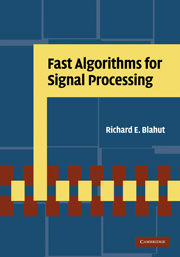Book contents
- Frontmatter
- Contents
- Preface
- Acknowledgments
- 1 Introduction
- 2 Introduction to abstract algebra
- 3 Fast algorithms for the discrete Fourier transform
- 4 Fast algorithms based on doubling strategies
- 5 Fast algorithms for short convolutions
- 6 Architecture of filters and transforms
- 7 Fast algorithms for solving Toeplitz systems
- 8 Fast algorithms for trellis search
- 9 Numbers and fields
- 10 Computation in finite fields and rings
- 11 Fast algorithms and multidimensional convolutions
- 12 Fast algorithms and multidimensional transforms
- A A collection of cyclic convolution algorithms
- B A collection of Winograd small FFT algorithms
- Bibliography
- Index
3 - Fast algorithms for the discrete Fourier transform
Published online by Cambridge University Press: 03 May 2011
- Frontmatter
- Contents
- Preface
- Acknowledgments
- 1 Introduction
- 2 Introduction to abstract algebra
- 3 Fast algorithms for the discrete Fourier transform
- 4 Fast algorithms based on doubling strategies
- 5 Fast algorithms for short convolutions
- 6 Architecture of filters and transforms
- 7 Fast algorithms for solving Toeplitz systems
- 8 Fast algorithms for trellis search
- 9 Numbers and fields
- 10 Computation in finite fields and rings
- 11 Fast algorithms and multidimensional convolutions
- 12 Fast algorithms and multidimensional transforms
- A A collection of cyclic convolution algorithms
- B A collection of Winograd small FFT algorithms
- Bibliography
- Index
Summary
One of our major goals is the development of a collection of techniques for computing the discrete Fourier transform. We shall find many such techniques, each with different advantages and each best-used in different circumstances. There are two basic strategies. One strategy is to change a one-dimensional Fourier transform into a two-dimensional Fourier transform of a form that is easier to compute. The second strategy is to change a one-dimensional Fourier transform into a small convolution, which is then computed by using the techniques described in Chapter 5. Good algorithms for computing the discrete Fourier transform will use either or both of these strategies to minimize the computational load. In Chapter 6, we shall describe how the fast Fourier transform algorithms are used to perform, in conjunction with the convolution theorem, the cyclic convolutions that are used to compute the long linear convolutions forming the output of a digital filter.
Throughout the chapter, we shall usually regard the complex field as the field of the computation, or perhaps the real field. However, most of the algorithms we study do not depend on the particular field over which the Fourier transform is defined. In such cases, the algorithms are valid in an arbitrary field. In some cases, the general idea behind an algorithm does not depend on the field over which the Fourier transform is defined, but some small detail of the algorithm may depend on the field.
Information
- Type
- Chapter
- Information
- Fast Algorithms for Signal Processing , pp. 68 - 114Publisher: Cambridge University PressPrint publication year: 2010
Accessibility standard: Unknown
Why this information is here
This section outlines the accessibility features of this content - including support for screen readers, full keyboard navigation and high-contrast display options. This may not be relevant for you.Accessibility Information
- 2
- Cited by
